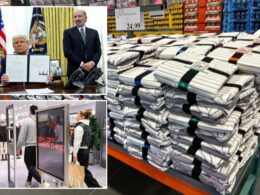
The economy added a whopping 254,000 jobs last month — blowing past forecasts that predicted a modest rise and diminishing Wall Street’s hopes of another big rate cut from the Federal Reserve next month.
The Labor Department also reported that the unemployment rate fell to 4.1% — a decline from 4.2% in the previous month.
Consensus estimates had the number of jobs created last month at 150,000 — up from the 142,000 jobs that were reported in August.
The unemployment rate in August declined slightly to 4.2% after unexpectedly rising to 4.3% in July.
Federal Reserve Chair Jerome Powell signaled Monday that more interest rate cuts are in the pipeline but suggested they would occur at a measured pace intended to support a still-healthy economy.
At their last meeting Sept. 18, Fed officials reduced their rate to 4.8%, from a two-decade high of 5.3%, and penciled in two more quarter-point rate cuts in November and December.
On Monday, Powell said that remains the most likely outcome.
“If the economy performs as expected, that would mean two more cuts this year,” both by a quarter-point, Powell said.
Earlier this week, data provided by ADP found that private sector companies added 143,000 jobs in September — which was above analyst estimates for 125,000 and much higher than the 99,000 jobs that were added in August.
The increase in jobs added to the private sector snapped a streak of five straight months of declines.
But there was also data that pointed to a weakening job market. The Labor Department said earlier this week that the quits rate — a key metric indicating worker confidence in the economy — dropped to 1.9% in August compared to 2% in July.
The 1.9% rate is the slowest pace since June 2020.
Another metric, the Job Openings and Labor Turnover Survey (JOLTS), found that the hiring rate hit 3.3% in August — down from 3.4% in July.
Excluding the pandemic, the 3.3% rate was the lowest since August 2013, according to Yahoo! Finance.
Posted job openings, too, have declined steadily, to 8 million in August, after having peaked at 12.2 million in March 2022.
The labor market is still reliably cranking out jobs each month, enough to give Americans the confidence and paychecks to keep spending and sustaining the economy.
Yet the pace of hiring has lost momentum over the past several months, evidence that employers have become more cautious.
Employers added an average of just 116,000 jobs a month from June through August, including a dismal 89,000 in July.
That marked the weakest three months of hiring since mid-2020.
Hiring has plummeted from a record average of 604,000 a month in 2021 at the end of COVID recession and 377,000 in 2022.
Despite the cooling labor market, the economy has remained resilient overall — growing at a vigorous 3% annual pace from April through June thanks to consumer spending and business investment.
A forecasting tool from the Federal Reserve Bank of Atlanta points to slower but still healthy 2.5% annual growth in the just-ended July-September quarter.
The resilience has come as a relief.
Economists had expected that the Federal Reserve’s aggressive campaign to subdue inflation — it jacked up interest rates 11 times in 2022 and 2023 — would cause a recession.
It didn’t. The economy kept growing even in the face of ever-higher borrowing costs for consumers and businesses.
Last month, the Fed began cutting rates, in part to try to bolster the slowing job market.
The economy is weighing heavily on voters as the Nov. 5 presidential election nears.
Many Americans are unimpressed by the job market’s durability and are still frustrated by high prices, which remain on average 19% above where they were in February 2021.
That was when inflation began surging as the economy rebounded with unexpected speed and strength from the pandemic recession, causing severe shortages of goods and labor.
Across the economy, most indicators look solid.
With Post Wires








